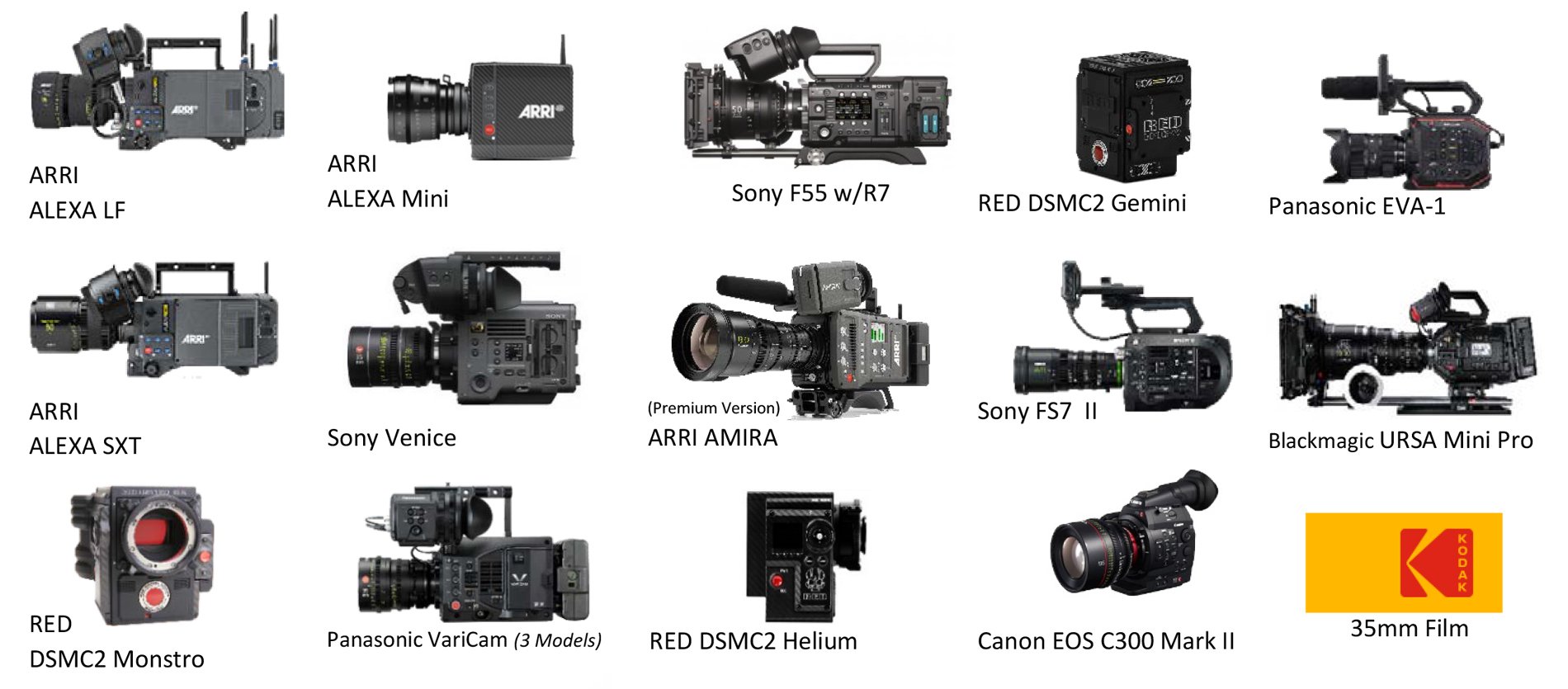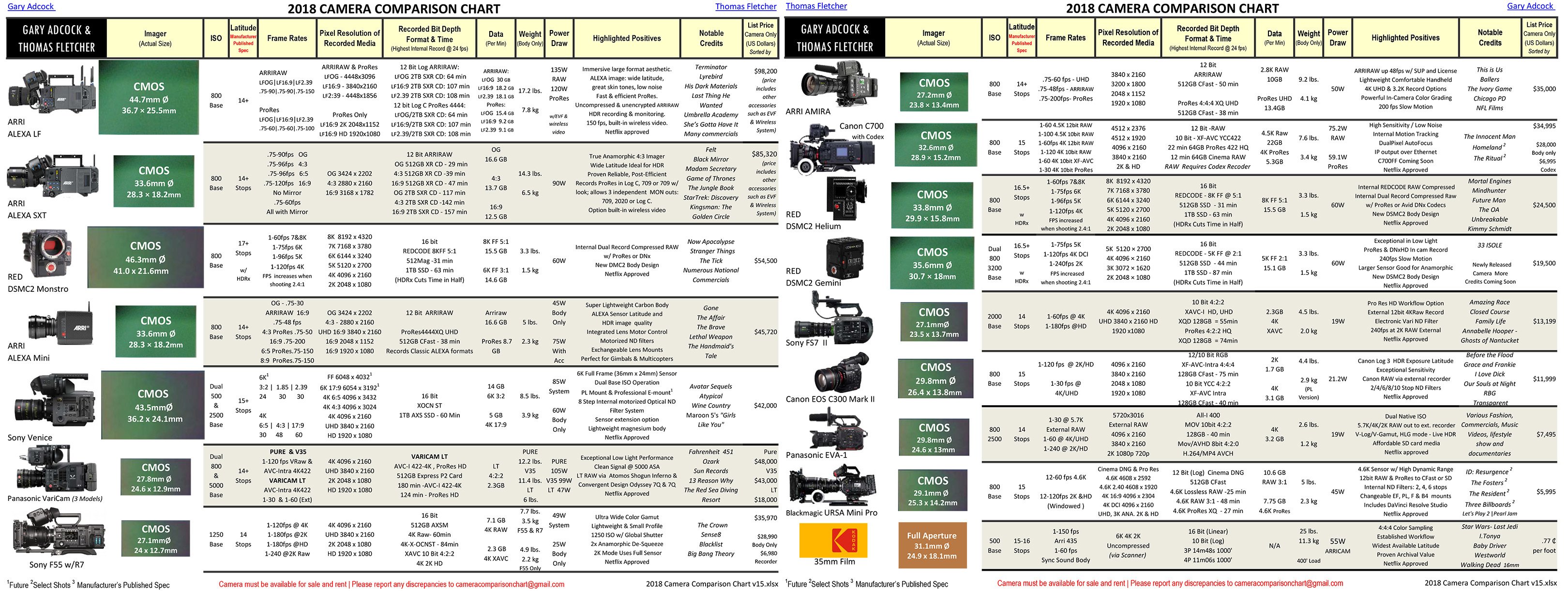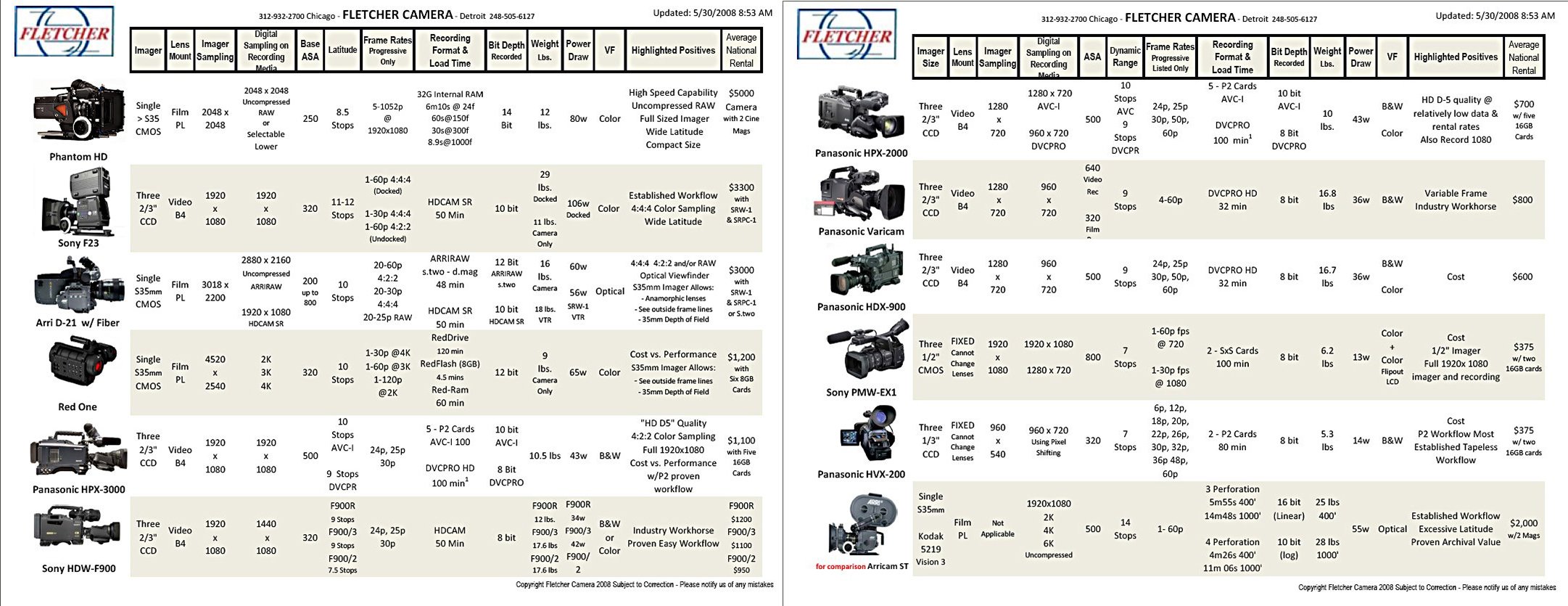
2018 Camera Comparison Chart
Created by ASC associate member Tom Fletcher and Gary Adcock, the latest edition of this informative tool arrives today as an American Cinematographer exclusive.
Created by ASC associate member Tom Fletcher and Gary Adcock, the latest edition of this informative tool arrives today as an American Cinematographer exclusive.
This Camera Comparison Chart is the latest in an annual series published by Fletcher since 2007, each featuring Adcock’s assistance as technical advisor and the assistance from various cinematographers (including ASC members Robert Primes, David Stump, Bill Bennett and ASC President Kees van Oostrum), colorists, rental houses and camera manufacturers.
In 2017, Adcock took over the reins as the main contact and producer when Fletcher assumed duties with an unaffiliated manufacturer.
The Camera Comparison Chart was originally designed to assist cinematographers to help them better educate their clients, highlighting needs and use while also sharing “average” daily rental prices. It started with a request from cinematographer Peter Klein, who asked Fletcher for a document to explain the differences between the 1/3"-sensor camera his agency wanted to use and the other HD options available to them. “To the agency, HD was HD,” Fletcher remembers. “It worked and the producer followed the DP’s recommendation. Peter shared the document with other DPs and I continued to hear great feedback.”


The popularity of the Camera Comparison Chart began after Tom shared it with the other rental houses that had shared information to help complete the data set and grew exponentially as professional camera systems transitioned to digital capture. In the beginning, it focused on popular cameras available for rent in the larger markets to help producers understand the needs of their production and the differences in cameras at the dawn of the HD era.
“Showing the image size of the sensors was the key component,” says Fletcher. The Camera Comparison Chart is still created with this in mind so that a DP can clearly discuss this with their producer.
Adcock notes he has "seen the Camera Comparison Chart in rental houses around the world,” and that there is nothing like walking into a rental house or film school in places like Dubai, Bogota, Cairo, Amsterdam, London, Mumbai, Paris, Shanghai, Madrid, Munich, Berlin, Taiwan or Rome and see it mounted on the wall for everyone to use.
In 2014, the chart changed from offering rental information to something that more reflected the changing state of media and entertainment, with its focus now on the camera systems that people could invest in and own as manufacturers started delivering increasingly cost-effective solutions for cinematic acquisition

“It takes weeks that blur into months of work [to complete],” says Adcock of creating the Camera Comparison Chart, “and it’s never really ever really finished; there are far too many camera and too much information to be able to maintain this as a living archive, so we cut tons of things due to our restriction that everything must fit on two pages of 8.5" x 11" paper. The biggest complaint is always, “Why did you leave X off the chart?” There are only 15 lines available on the two pages. Cameras must be for sale and SHIPPING at publication; just because a manufacturer wants something on the chart does not mean they get it. [Every year] we have had a number of companies upset about being left off. And while for the last few iterations of the chart have been dominated by Red and Arri, we have in the past included Phantoms, DSLRs and many mainstream broadcast cameras.

“Another issue is just compiling all of the data. The manufacturers include various info, yet sometimes it changes after a product ships and data like the power draw varies widely depending on how it is tested and with what accessories. Secondly, the cameras we list pricing for are for body-only configurations, if available. We have never included pricing for mods or accessories that are required to make the package complete, there are just too many variables to consider to include all of that kind of information. We spend a good deal of time talking to people that work with these cameras every day so that we can extract information. We also openly ask for help from a variety of people in the industry.”
Fletcher and Adcock’s intention is for the Camera Comparison Chart is to be used as a guide to formats, recording media, bit depth and power consumption. “It allows the user to make a qualified judgment on where they want their production to start,” says Adcock. “We do not account for shooting styles — though PL mounts do dominate. We focus on giving producers, DPs and even students a comprehensive grasp of the available tools and technologies. We just put all the info together in a single place and STRONGLY SUGGEST THEY TEST FOR THEMSELVES.”
Adcock adds that creating the Camera Comparison Chart requires a “stunning amount of work that we do completely for free. Neither Tom nor I receive any funds or support for our efforts. It’s a labor of love. I’ve had so many meetings with DPs over the years that began with, ‘First, I want to say I love your charts — don’t ever stop making them.’ At the ASC Awards and at Camraimage, my wife finds it easier to introduce herself to DPs as the ‘wife of the guy who does the Camera Comparison Chart.’”
Previous Editions of the Camera Comparison Chart:
Adcock and Fletcher would like to thank those who offered assistance and feedback in the collection of the data:
- Geoff Boyle, cinematographer
- John Deboer, Sim
- Scott Dale, VER
- John Deboer, Sim
- Megan Donnelly, AbelCine
- Stosh Durbacz, Fujifilm
- Phil Holland, cinematographer
- Michael Koerner, Koerner Camera
- Jim Mathers, cinematographer
- Mike Sippel, Arri Rental
- David Stump, ASC, cinematographer
- Marcelo Trotta, ABC, cinematographer
- Bruno Vieira, cinematographer
- Adam Wilt, technologist
- ARRI
- Susanne Mayer
- Frederick Merten
- Marc Shipman-Mueller
- BLACKMAGIC DESIGN
- Tor Johansen
- Tim Schumann
- CANON
- Joe Bogacz
- Alan Craig Lewis
- Tim Smith
- Larry Thorpe
- KODAK
- Mike Brown, Kodak
- PANASONIC
- Steve Cooperman
- Mitch Gross
- Stephen Mahrer
- Barry Russo
- RED
- Brent Carter
- Brian Henderson
- Kenta Honjo
- Alan Zarnegar
- SONY
- Peter Crithary, Sony
- Simon Marsh, Sony






